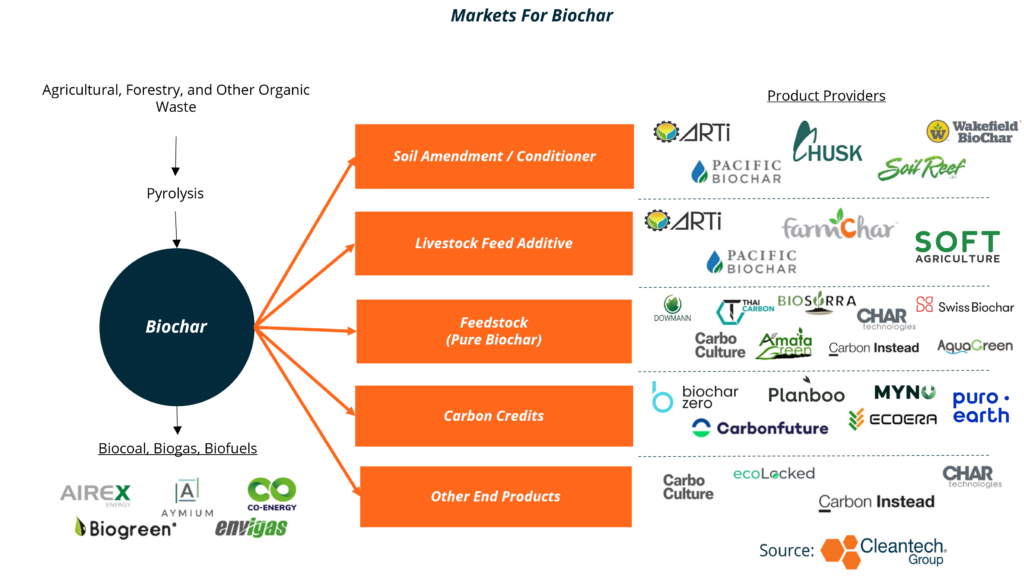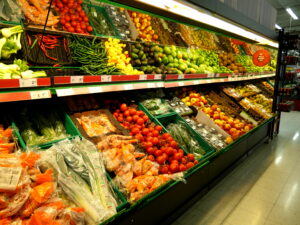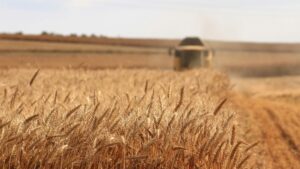Valorizing Agrifood Waste Streams into Biochar
Biochar is a carbon-rich powdered or granular substance produced by burning organic biomass in a low-oxygen environment; a process called pyrolysis. Biochar can be used as a soil amendment or fertilizer additive, boosting soil’s nutrient and water retention capacity, and in turn enhancing crop resilience and yield.
The feedstock for biochar production is organic biomass such as crop and forestry residues, which can be readily sourced from farmers and landowners seeking to valorize waste streams. In addition, biochar offers a relatively simple way to sequester carbon and offset greenhouse gas emissions. Up to 3 tons of carbon can be sequestered per ton of biochar produced, according to Chemists Without Borders.
A December 2023 study by Aarhus University and the Geological Survey of Denmark and Greenland found that around 75% of commercially available biochar can potentially store carbon for hundreds of thousands, if not millions, of years, underlining its promise as a permanent CO2 removal technology.
Nevertheless, biochar faces several hurdles to wider adoption, including equipment availability issues, variable output quality, and a lack of standardization. The most promising opportunities for innovation and investment in biochar center on these areas.
International Projects Will Outpace North America and Europe
A typical biochar project can take 24-36 months to come online, largely due to long equipment manufacturing lead times of over 16 months, presenting a significant barrier to receiving project financing.
In North America and Europe, equipment, labor, and maintenance costs for setting up a biochar project can exceed three times that of projects in emerging markets. More equipment manufacturers are needed to reduce lead times and make production economically viable. Until then, projects in rural and developing communities will encourage the initial uptake of biochar, with offtake agreements enabling the required infrastructure investments.
International projects launched in 2023 include:
- Senegal: Canada-based Echo Tech Carbon partnered with rice farmers to produce 350K tons per annum (tpa) of biochar
- Brazil: French start-up and 2022 XPRIZE winner, NetZero, built a 4.5K tpa biochar plant
- Kenya: BIOSORRA partnered with Kenya Nut Company to build the largest biochar plant in East Africa
- Mexico: General Biochar Systems, by The Next 150, launched a 6K tpa biochar facility in addition to value-add products like biofuel and hydrogen
Carbon Dioxide Removal Credits Increased 20-fold from 2005-2021
Sales of biochar-based carbon dioxide removal (CDR) credits increased 20-fold from 2005-2021, encouraging some project financing for biochar producers (Geoengineering Monitor 2023).
Biochar-based credits generally range in price from $150-$200 per ton of CO2 removal; the industry’s goal is to get to under $100 per ton in order to be competitive with other CDR methods such as marine CDR, Direct Air Capture, etc. However, compared to other CDR methods, biochar has a relatively mature technology readiness level (TRL) of 8 (NEGEM).
Moreover, while only 2.8% of all CDR credits purchased have been delivered on average across all CDR methods, (CDR.fyi), biochar projects stand out having delivered 38.8% of the total sold.
In December 2023, Microsoft purchased 32,000 tons of biochar-based CDR credits from Carbonfuture to be delivered by June 2024 from the Exomad Green Concepción project located in Bolivia.
Barriers to Adoption
A lack of standardization across the biochar industry presents a barrier to wider adoption. The EU’s European Biochar Certification is the only regulatory framework by any government agency for biochar to be used in agriculture.
Two verification standards are available: the Puro Standard by Puro.earth, and the Verified Carbon Standard (VCS) methodology by Verra. The International Biochar Initiative (IBI) has launched biochar global standardization and certification proposals and is due to release a biochar market analysis early this year.
Furthermore, biochar distribution for agricultural applications beyond a 150-200 km radius around the production site begins to outweigh its CDR potential, necessitating a decentralized approach. New deep tech solutions are emerging to improve upon these logistical issues and beyond.
Innovation to Keep an Eye Out For
Texas-based Climate Robotics provides on-site production of biochar via mobile tractor pyrolyzers equipped with AI to maximize quality output of biochar based on the feedstock. Likewise, Takachar manufactures small-scale portable units with 5-10 t/day biochar output capacity.
Kenyan-based BIOSORRA is manufacturing fast pyrolysis equipment in-house with up to 10K tpa capacity that generates ~35% yield of dry biochar. BIOSORRA aims for external manufacturing capacity within a decade.
México-based Húmica has developed a soil assessment tool equipped with AI-powered recommendations to provide turnkey biochar-based recipes that are fit-for-purpose for a variety of soils, environments and crops.
At the lab-scale, researchers at Iowa State University’s Bioeconomy Institute won Elon Musk’s $1M XPRIZE Carbon Removal award for developing a self-heated, automated bioreactor system to process agricultural manure into biochar and biofuels.
As standardization encourages more wide-scale adoption, biochar producers will begin manufacturing finished value-add products in-house that can be done at little additional cost, e.g., biofuels, fertilizers, livestock feed, etc. And biochar has seen its way into other industries like construction materials, cosmetics, and even as fuel for smelting steel.
Key Deals in Q4 of 2023
- December 2023 – Climate Robotics, developer of mobile robots leveraging AI to generate biochar, raised a $43M Series A disclosed via SEC filing
- November 2023 – Carbo Culture, producer of biochar and biocharcoal via fast pyrolysis, raised an $18M Series A from GenZero and True Ventures
- August 2023 – Standard Biocarbon, producer of biochar using a containerizer pyrolyis process, raised a $5.15M Series A disclosed via SEC filing




